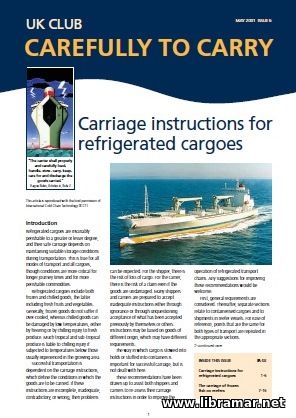 Refrigerated goods have also been considered invariably perishable and that is one of the main reasons why their safe transportation will always be dependent on proper maintaining of the required carriage conditions of storage during the carriage. Actually, this is true for literally all cargoes and modes of transportation, though the conditions are seriously more critical for longer journeys. Refrigerated goods usually include both the chilled and frozen cargoes.
The chilled ones include fresh vegetables and fruits. Frozen products would not typically suffer in case of the over-cooling, while the chilled products could easily get damaged by the low temperatures. The final success and effectiveness of the whole marine transportation would mainly depend on thorough following the proper carriage instructions defining the conditions in which such types of cargo should be transported.
The valuable technical recommendations provided in the present document were drawn-up in order to provide the required assistance to both carriers and shippers in order to assess their transportation instructions with the final aim to improve the operation of the transport chains. Firstly, the general applicable requirements have been considered; this one is followed by the sections dedicated to the containerized goods and shipments that are undertaken by means of the reefer vessels...
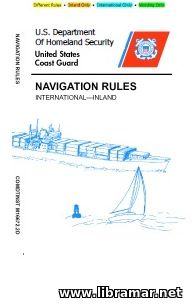 The regulatory documentation included in this pack of papers was prepared and issued by the US Department of Transportation - USCG. NavRules International/Inland as of July 2013. The publication contains Introduction, Legal Citations, Conversion Table, Navigation Rules, Interpretative Rules, Demarcation Lines in accordance with the COLREGs, Penalty Provisions, Waters that have been specified by the Secretary, Alternative Compliance, Regulations on Vessel BTB (Bridge-to-bridge) Radiotelephone Communications, possible Exemptions from the certain provisions of these Rules that can be granted, various Navigational equipment including lights, shapes and signaling equipment. Demarcation Lines as per ColRegs have also been addressed.
This set of USCG Rules have been separately marked in order to demonstrate the existing differencies between the United States Inland and the International versions of these Rulebooks by means of the four different color codes, namely yellow, orange, blue, and green - the explanation on the use of the colors is there on the first pages of the book. The publication was released by Star Path School of Navigation.
And, we would highly recommend this set of books because of the second file containing the above mentioned Rules supplemented with the valuable descriptive annotations that have been provided by the maritime professionals that will be of particular use to the people having any sort of difficulties with understanding and feeling the spirit of the Rules.
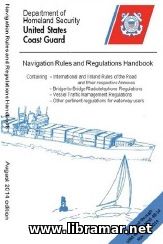 This is the pack of regulatory documentation released by the USCG and consisting of two separate volumes addressing the Navigation Rules and Regulations. It contains both the Inland and International USCG-issued "Rules of the Road" together with their respective Annexes, regulations concerning the VTM (Vessel Traffic Management) and Bridge-to-bridge Radiotelephone Communications, together with all other relevant regulations for the waterway users. Effective date is 22 November 2014.
The second file contained in this pack is a Corrigendum, and it contains corrections, deletions, and also the insertions that are to be done to the Handbook. Such notes are denoted a black bold type. The publication starts with the legal citations followed by the conversion table. The main content of this document has been arranged in several subparts. The first one titled "General" will describe the application of this Rulebook and outline the responsibilities of all parties involved; moreover, it will list the general definitions used.
The other subparts address the sailing and steering rules, navigation lights/shapes, sound signals, light signals, exemptions from the requirements, penalty provisions, instructions on proper implementation of the rules, general operation of the ships, traffic management and other valuable relevant information.
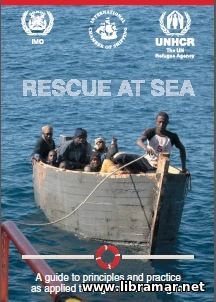 The present booklet is dealing with the sea rescue and is intended to provide the marine industry with the required guidance concerning the main principles and established practice applied to the refugees and migrants. Nowadays, sea-borne refugees and migrants shall not be considered as a sort of a new phenomenon.
People have always and everywhere risked their lives sailing aboard the ships that were not seaworthy enough or using other crafts that could not provide the required level of safety. The SAR - standing for the search and rescue - services allover the world depend on vessels, mostly merchant, in order to be able to assist people in distress. Today, the signals of distress can be transmitted by means of the satellite as well as terrestrial types of communication both to the vessels in immediate vicinity and to the SAR authorities located ashore.
This would allow the rescue operation to go smoothly and well-coordinated. This document was worked out by the IMO together with the UNHCR and is intended to provide all interested people, including crew members, owners, masters, insurance companies, government authorities, flag administration and PSC officers and others, with the guidelines addressing the legal provisions and procedures in order to ensure that the disembarkation of the rescued human goes smooth, and to propose effective measures to meet all specific needs of the survivors...
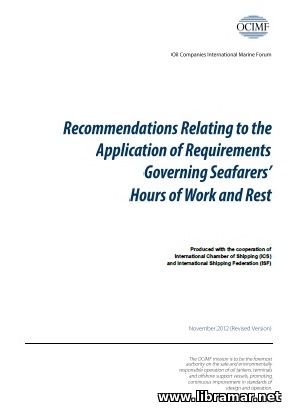 For years, fatigue has been treated as one of the most serious factors historically contributing to the vast majority of incidents occurring in the maritime industry. In the attempt to get the fatigue minimized, the appropriate legislation addressing the regulating of the hours of work/rest of the seafarers has been there and is duly controlled and thoroughly monitored to ensure their strict compliance with Flag Authorities legislation that are being enforced by means of the established PSC procedures.
But is should also be noted as necessary that the overall enforcement measures were relatively ineffective. The present official paper has been developed with the intention of its authors to highlight the key areas of concern related to the potential uncertainties plus various different interpretations of the requirements contained in the relevant international conventions.
Moreover, the authors of the volume have also considered the minimum industry expectations in order to provide the proper compliance with all relevant technical recommendations and provisions provided to keep all members of the OCIMF organization together with the ship managers ashore and ship crew members duly updated. The recommendations cover the legislative background, recommendations and possible ambiguities of UIs, with the separate chapter being dedicated to the further recommendations relating to the practical compliance.
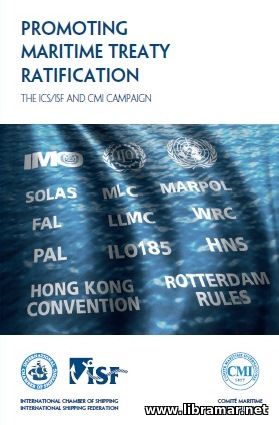 Very short publication released by ISF and ICS describing the major points of CMI (Comite Maritime International) campaign of promoting maritime treaty ratification. ICS is the association representing all trades and sectors of the shipping industry. In turn, ISF is the international organization for maritime employers. The CMI was established in Antwerp, Belgium more than a century ago, in 1897, and it is an international association of maritime lawyers.
Both ISF and ICS continually emphasize to their respective governments that the international maritime industry of today is seriously dependent on a global regulatory system to operate efficiently. And now, this endeavor is supported by CMI, as well. The three above stated organizations respected and recognized in the world of shipping, will now jointly assist the countries where the ratification of the major Conventions has been limited.
And the main purpose of the present brochure is to reiterate the main reasons standing behind this campaign and also to provide the shipping industry with a good and timely update on the very latest developments that would play a role. It is to highlight the particular Conventions considered by these three organizations as the most important for the governments of the above stated countries to be ratifies as a priority...
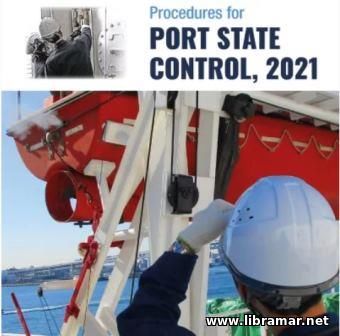 The present regulatory document has been mainly intended to provide all interested persons with the required basic guidance on proper conducting of the PSC inspections that would consequently result in improved consistency in performing such inspections, as well as correct recognition of deficiencies of the vessels, their equipment, crew, and application of the correct control procedures. The publication has been arranged in five major chapters addressing the general provisions, port state inspections themselves, contravention and detention issues, requirements for proper PSC inspection reporting, and applicable review procedures.
There are also numerous appendices in the book that provide some additional information, for example they provide the guidance for the detention of vessels, control of operational requirements, for PSC relating to the ISM Code, LRIT, inspections and investigations conducted under Annexes I and II to MARPOL Convention, discharge requirements, structural/equipment requirements, ITC 1969 Convention, Flag State comments, IMO PSC procedures, manning standards, list of applicable documents and certificates, as well as of the documentation relevant to the PSC procedures, etc.
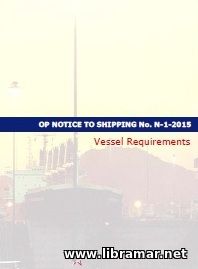 Here is the collection of the the OP Notices officially issued by Panama Canal authorities. The pack consists of thirteen publications. The first one is titled "Vessel requirements" has been arranged in four major parts addressing the effective date and cancellation of the notice, it's purpose and scope, communication channels, navigation bridge features that are required on transiting ships; in addition to that, the boarding arrangements required by the Panama Canal authorities have been dealt with, together with the procedure for embarking/disembarking during the transit.
The second publication is "Harbor operations" and it lists the regulations and rules that are applicable to the control of the ships movement in the Panama Canal. The third paper, "Communication on transit activities" presents a compilation of the means of communicating pertaining to the transit activities. The remaining documents address the illegal activities, official transits, guest transits, courtesy transits, embarkation and disembarkation at the time of the transit, transit reservation system, attachment of ships by PM tribunals, investigation of the accidents, operation testing of the equipment, small commercial/non-commercial craft operation, PCSOPEP requirements, and ISPS Code requirements.
« 1 2 ... 18 19 20 21 22 ... 24 25 » |







